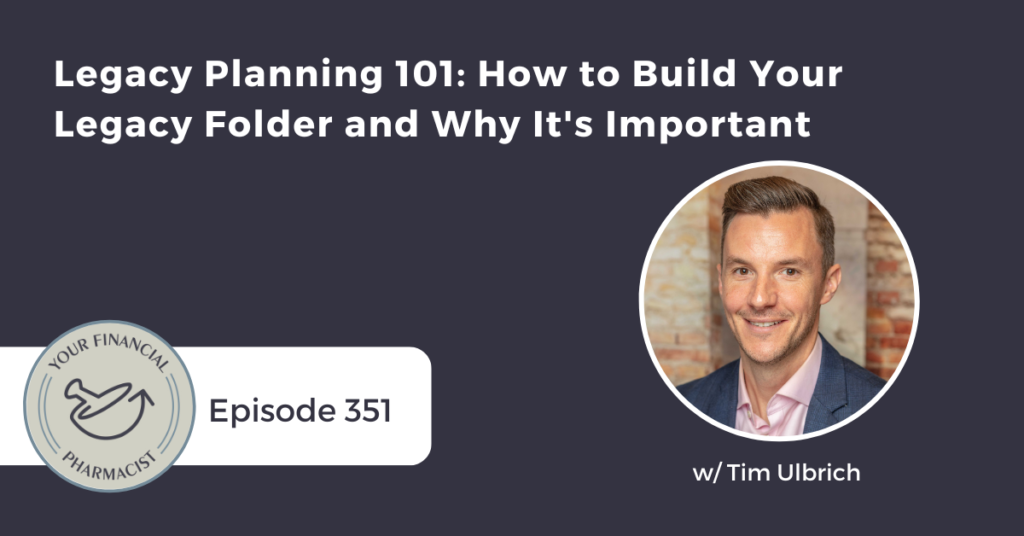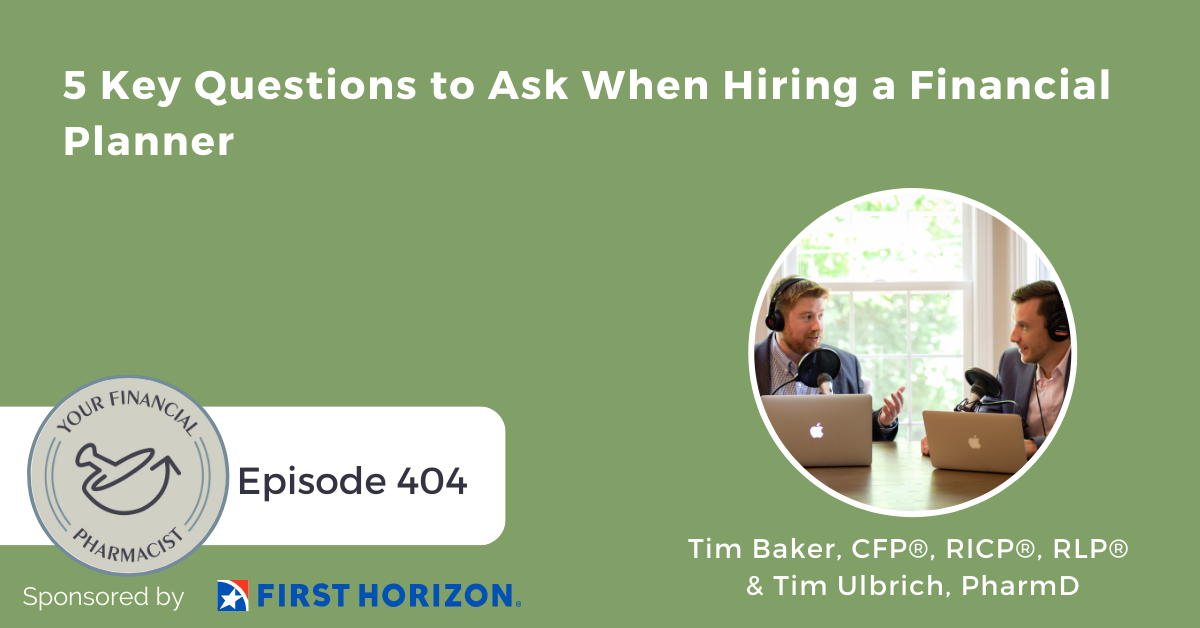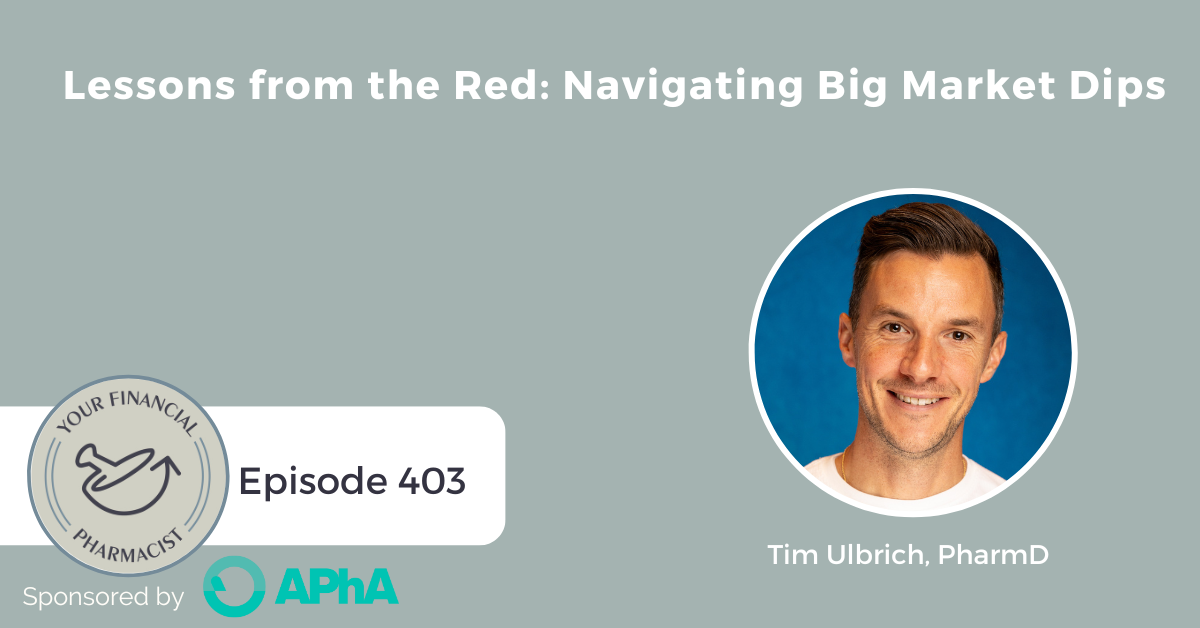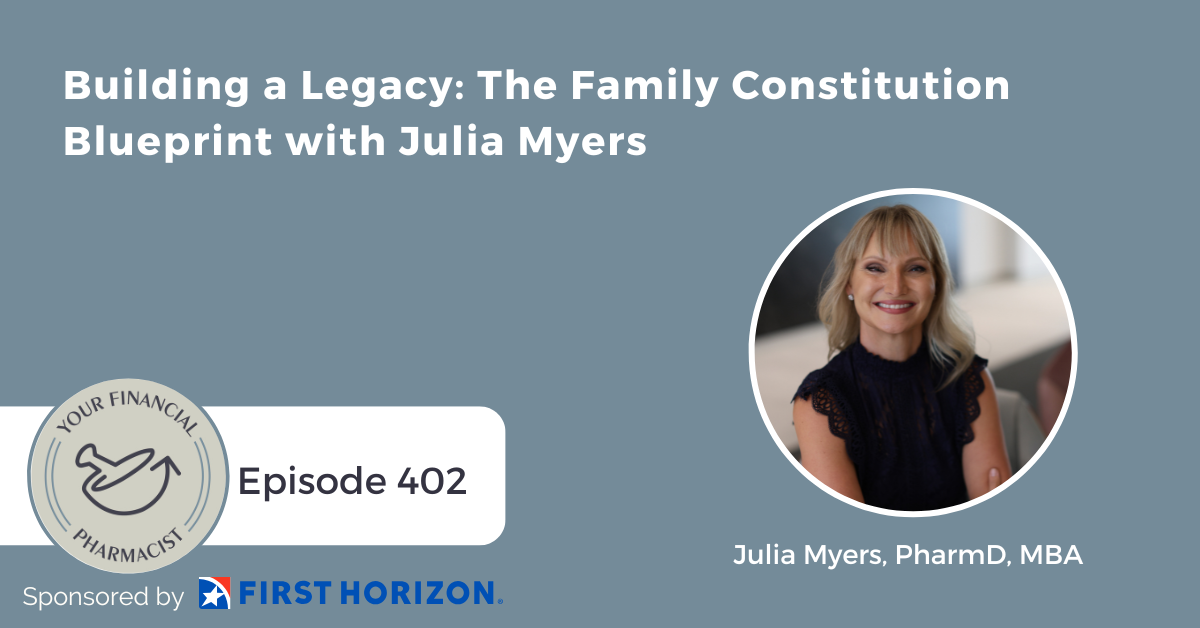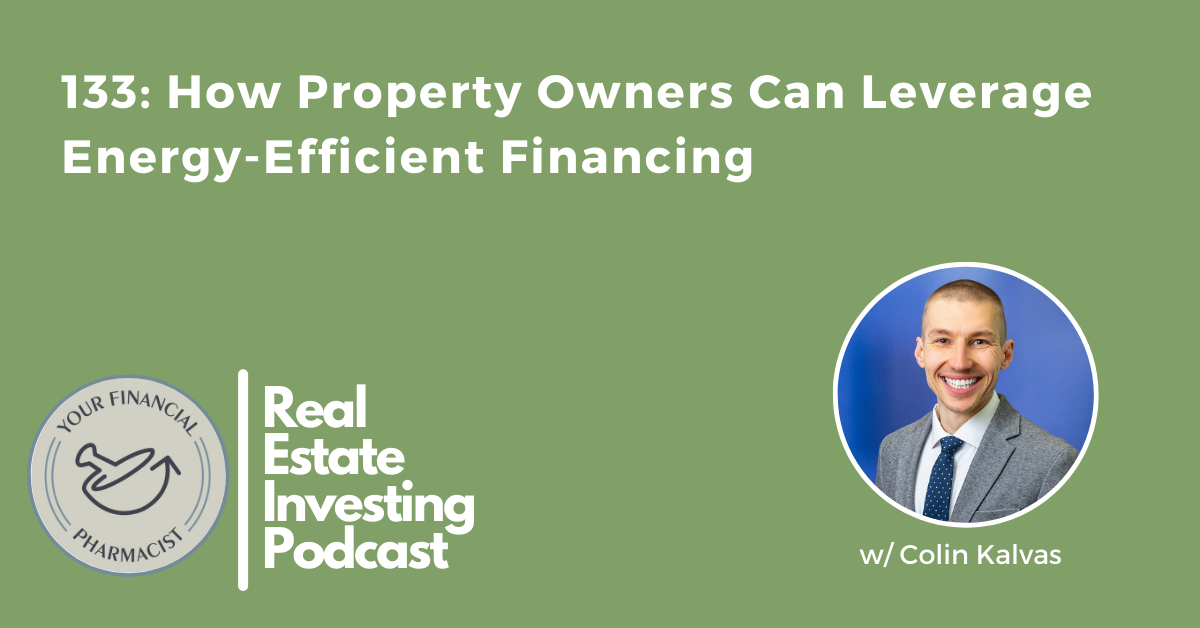Tim Ulbrich discusses the importance of creating a legacy folder to organize essential financial documents for access during emergencies and peace of mind.
Episode Summary
In this episode, YFP Founder and CEO, Tim Ulbrich, delves into the critical aspect of establishing a “legacy folder” to efficiently organize essential financial documents and accounts. This folder serves as a vital resource in emergencies, streamlining access for loved ones and averting confusion or delays. Drawing from personal experience, Ulbrich shares how he and his wife maintain their financial plan and essential documents in a shared electronic folder and a secure physical safe at home, ensuring accessibility and peace of mind during unforeseen circumstances.
Tim explores the contents of the legacy folder, which encompass a comprehensive checklist, electronic copies, and hard copies of vital papers such as birth certificates and social security cards and other critical documents like insurance policies and estate planning materials.
Learn how to proactively organize your financial affairs to safeguard against unforeseen events, ultimately fostering financial peace of mind and security.
About Today’s Guest
Tim Ulbrich is the Co-Founder and CEO of Your Financial Pharmacist. Founded in 2015, YFP is a fee-only financial planning firm and connects with the YFP community of 15,000+ pharmacy professionals via the Your Financial Pharmacist Podcast podcast, blog, website resources and speaking engagements. To date, YFP has partnered with 75+ organizations to provide personal finance education.
Tim received his Doctor of Pharmacy degree from Ohio Northern University and completed postgraduate residency training at The Ohio State University. He spent 9 years on faculty at Northeast Ohio Medical University prior to joining Ohio State University College of Pharmacy in 2019 as Clinical Professor and Director of the Master’s in Health-System Pharmacy Administration Program.
Tim is the host of the Your Financial Pharmacist Podcast which has more than 1 million downloads. Tim is also the co-author of Seven Figure Pharmacist: How to Maximize Your Income, Eliminate Debt and Create Wealth. Tim has presented to over 200 pharmacy associations, colleges, and groups on various personal finance topics including debt management, investing, retirement planning, and financial well-being.
Key Points from the Episode
- Building a legacy folder for financial peace of mind. [0:00]
- Creating a “legacy folder” for financial documents. [2:36]
- Important documents, insurance policies, estate planning, and car titles. [6:50]
- Organizing financial documents for emergency situations. [14:59]
Episode Highlights
“So when it comes to why having a legacy folder is important. Getting organized with your financial records plays a significant role not necessary in terms of moving the needle on your net worth but in making sure you and others have access to all the information that you need to make informed decisions.” – Tim Ulbrich [2:24]
“Now, what is the legacy folder? So essentially the idea of a legacy folder, whether it’s a physical copy and electronic copy, or combination of both. It’s a place where you have all of your financial related documents. So in the event of an emergency, others will be able to quickly assess your financial situation and get access to all of the documents and accounts that pertain to your finances.” – Tim Ulbrich [4:07]
“Don’t underestimate the peace of mind and the clarity that can come from having this information collected.” -Tim Ulbrich [5:25]
“Once you get organized with your information, you’re going to be walking from that point of confidence, you’re going to feel prepared in taking action on other parts of your financial plan.” – Tim Ulbrich [16:49]
Links Mentioned in Today’s Episode
- YFP Legacy Folder Checklist
- YFP 222:Why Estate Planning is Such an Important Part of the Financial Plan
- YFP 310: Dusting Off Your Estate Plan
- YFP Net Worth Tracking Sheet
- The Millionaire Next Door by Tom Stanley
- Check your Social Security Statements
- Financial Peace University
- Subscribe to the YFP Newsletter
- YFP Planning
- Tim Ulbrich on LinkedIn
- YFP on Instagram
- YFP Facebook Group
- Your Financial Pharmacist
- YFP Disclaimer
- YFP Newsletter
Episode Transcript
[INTRO]
Tim Ulbrich 00:00
Hey everybody, Tim Ulbrich here and thank you for listening to the YFP Podcast where each week we strive to inspire and encourage you on your path towards achieving financial freedom. This week I’m talking through Legacy Planning 101: How to Build your Legacy Folder and why it’s important. To assist with implementing this important step and your own financial plan, make sure to download the YFP Legacy Folder Checklist at yourfinancialpharmacist.com/legacy. This checklist includes a list of 15+ financial related documents that you can have a record of in your legacy folder. It helps you identify key parts of your financial plan that you may or may not have in place but need to get started. And it helps give you peace of mind knowing that in the event of an emergency, all of your financial documents are organized in in one location. Again, you can access that free checklist at yourfinancialpharmacist.com/legacy.
Tim Ulbrich 00:51
Now before we jump into today’s episode, I have a hard truth for you to hear making a six figure income is not a financial plan. Yes, you’ve worked hard to get where you are today. Yes, you’re earning a good salary. But have you ever wondered, am I on track to retire? How do I prioritize and fund all these competing financial goals that I have? How do I plan financially for big upcoming life events? Whether that be moving, having a child, changing jobs, getting married or retiring? And why am I not as far along financially at this point in my career, as perhaps I thought I should be? The answer your six figure income is not a financial plan. As a pharmacist, you have an incredible tool in your toolbox your salary, but without a vision and a plan that good income will only go so far. That’s in part why we started Your Financial Pharmacists back in 2015. At YFP we support pharmacists at every stage of their career to take control of their finances reach their financial goals and build wealth through comprehensive fee only financial planning and tax planning. Our team of professionals including certified financial planners and a CPA, work with pharmacists all across the US and help our clients set their future selves up for success while living their rich life today. Ready to see how Your Financial Pharmacist can support you on your financial journey? The next step is to book a free discovery call with our team by visiting YFPplanning.com Again, that’s YFPplanning.com Alright, let’s jump in today’s episode.
Tim Ulbrich 02:18
Hi there, Tim Ulbrich here. Welcome to this week’s episode of the YFP Podcast. I’m flying solo this week to discuss legacy planning 101: how to build your legacy folder and why it’s important. Now this episode is going to be a brief one. But I hope you can walk away with a specific action item or to relate it to your own financial plan. Whether that be to create a legacy folder if you don’t already have one or if you do to make sure that you look at it and update that information if it’s been a while. So when it comes to why having a legacy folder is important. Getting organized with your financial records plays a significant role not necessary in terms of moving the needle on your net worth, but in making sure you and others have access to all the information that you need to make informed decisions. Think for a minute about all the various financial accounts, documents, records, insurance policies, tax returns that you have right, the list quickly grows to be one that is overwhelming. And the more you operate in your own system, the easier it is to navigate for you. But unfortunately harder for others to unravel, should they have to do so in the future. Right? Think of a situation where in the event of an emergency, you have this beautiful system you’ve created, you know where all your accounts are all your files, all your passwords, but unfortunately, others aren’t able to readily access that and to make sense of that information.
That’s where the legacy folder concept comes in. I actually first heard of this idea, it’s not my idea, I first heard of it when taking Dave Ramsey’s Financial Peace University class, this was probably 15 years ago through our local church. And I remember walking away thinking, wow, that is so obvious, yet so important. And something that Jess and I hadn’t yet done at that point in our financial plan. Now, what is the legacy folder? so essentially the idea of a legacy folder, whether it’s a physical copy and electronic copy, or combination of both, which is what we have, and I’ll share more information about that. It’s a place where you have all of your financial related documents. So in the event of an emergency, others will be able to quickly assess your financial situation and get access to all of the documents and accounts that pertain to your finances. We just went through updating this – Jess and I did in our own financial plan, shifting everything to an electronic version with the exception of a couple things that we keep in a safe at home, so that in the event of something happening to Jess or I or both of us, those caring for our boys along with our financial planning team at YFP readily have access to all the necessary information that they would need.
So when I think of the importance of this, you know, it really is peace of mind but there’s a secondary part that we often don’t think about, which is it forces you to get organized right? When you go through this process, and I’ll talk about the different sections of our own legacy folder. When you go through this process, you quickly might realize, wow, I’ve got some areas of the plan that I need to clean up, I need to gather some information. And this like many other parts of the financial plan, sure, it takes a little bit of time to get set up. But once you have it set up, right, we’re then in that update or maintenance mode. And again, don’t underestimate the peace of mind and the clarity that can come from having this information collected. So what’s included in the legacy folder? Well, I mentioned our checklist before and if you didn’t already download that make sure to download the YFP legacy folder checklist, you can access that again, at yourfinancialpharmacist.com/legacy that will give you a good guide.
There’s no one right answer to this. So I’m going to talk through what we have in our legacy folder. And you can see maybe some of that makes sense. Or maybe you have other documents and sections that you would want to include. So here’s how we have it organized in a combination of a Google Drive a shared drive, and a safe at home with the password the master password to our One Password, which is the the password account that we use the password management account that we use, I have the master key password in a safe at home, along with some hard copies of some documents like birth certificate, social security card, etc. Those things are in the safe, everything else is stored electronically and anything that’s in the safe as referenced as such in the electronic documents so so keep that in mind to combination of an electronic folder we used to have this all in a paper copy it was in a blue folder, we used to joke with our my parents and our in laws that hey, if anything ever happens to Jess or I – get the blue folder! For obvious reasons, having everything in a hardcopy wasn’t ideal in terms of updating that as well as making sure that the integrity of documents stay in place.
Okay, so section one is what we call important documents. Okay, so these are birth certificates for Jess, for me, for our four boys, these are our social security cards for us and the boys, this is our marriage certificate. These are our passports. And these components, we keep in a fireproof safe at home, obviously, because the hardcopy is important to have. So that’s section one important documents.
Section two is insurance policies, and information. So this is something that we have to update. Some of these we have to update annually, others not so much. So for example, long term disability policies or term life policies unless something changes with those policies, you know, we’re not updating those on a regular basis. But this includes things like auto insurance policies, homeowners insurance policies, or umbrella insurance policy, or health insurance policies, long term disability insurance policies, and our term life insurance policies. And we have a couple of different term life policies and long term disability policies. So all of that is included here in section number two. Now, what I have done typically in the electronic version, is I’ll list these out. And then I have the the actual policy hyperlink. So it can be easily reference to get to the actual policy, right, whether that’s a term life, disability, or another type of insurance policy. So that’s section two insurance policies and information.
Section three is estate planning documents. So we have an electronic copy on the Google Drive folder, the shared folder, and then we have a hard copy of these as well, because of the wet signature that’s needed on these and each state is different. Ours is a wet signature with a note notarized copy. So we have a hard copy in the safe at home. So these include our revocable trust agreements, this is our healthcare power of attorney, this is our living will, our last will and testament, et cetera, a lot of work to be done here. Now, if you’re hearing those terms, and thinking, Wow, maybe I need to get my estate planning documents in place. We’re gonna be talking more about that on the podcast, but I would reference you back to Episode 222. We’ll link to that in the show notes, when we brought on a couple of attorneys to talk about why estate planning is such an important part of the financial plan, as well as Episode 310, when Tim Baker and I talked about dusting off the estate plan, so this is not a you set it and you’re done.
Again, most of the work is upfront. Sure, there’s an investment of time and money to get these documents created. Again, the value is in the process of getting these created. And then you’ll have to update these periodically. So Jess and I often joke that our youngest son, Bennett, he wasn’t named individually in our documents when we created the so I guess that’s how it goes right when you’re the fourth son in the family. So he’s represented – it does address future children. But it’s just funny that he’s not called out individually. So we’ve got some updating to do there. So that’s section three – estate planning documents. And again, we keep a hardcopy in the safe. And then we have an electronic version of that available as well.
Section four is car titles. Now I’m not sure how valuable these are based on the current conditions of our minivan and our other vehicle, but, you know, calling these an asset would be a stretch but nonetheless, they have some value. Okay, so we have the car titles, readily available in section four so that someone could quickly sell or transfer the title of the car if need be. That’s section four car titles.
Section five is all documents related to our homeownership, okay, this is the deed on our home. This is the HELOC that we have open in the event, essentially, we have this as a backup emergency fund or if we need to tap into some of the equity in the home. So this is the HELOC documents. This is another copy of our homeowners insurance just to have it all in one place as well. So any important document related to the home, obviously, information about the mortgage, all of that is here in Section Five.
Section six is probably the biggest document I think, or close to the biggest section, which is a summary of all of our financial accounts. It’s our net worth tracking sheet, which I’ve talked about before on this show. And it’s all of our social security statements. Now I was just talking with a group of pharmacists last night that I was presenting to and I was talking about, hey, how many of you have pulled your Social Security statements to see your projected benefits, and I kind of got this impression that it was very few if any, right. So if you haven’t done that, it’s a good action step you’re going to do if you go to ssa.gov, to look at your Social Security statements, it’s got good information on there on projected benefits, and you can see your work credits. It’s pretty cool.
But this is a section where I have a table of contents that explains every account we have, right. So at Ally Bank, we have our high yield savings account, we have our checking account. Here’s where we have our Roth IRAs. Here’s where we have our 401 K’s. Here’s where we have a Roth 401 K. For every single financial account that we have, what is the account name? What is the institution? Where’s the link to that account? And what are we using that account for. And then as I mentioned before, we use One Password to store all of our password information and shared between Jess and I and the master key to that Password account is inside of our lock safe at home. So essentially, in the lock safe, you get to the One Password document through that you can then access all the individual financial accounts.
Now I know I’ve talked about this before, but I really believe in the value and the importance of not only having a good idea of the summary of all of your accounts. But this is a good place to also be tracking your overall net worth and your trajectory of your financial health. Right net worth is your assets what you own minus your liabilities, what you owe. Tom Stanley talks about the importance of tracking your net worth in the book, The Millionaire Next Door, and he talks about those that develop and build wealth over time they think differently, right? What he’s talking about there is that they realized that their income is a good tool. But their income is only a tool if they’re applying that to building their assets and paying down their liabilities, which ultimately is translating into their net worth.
So Jess, and I track our net worth on a monthly basis. It’s a very simple spreadsheet. If you want to see what that spreadsheet looks like I have that in the toolbox, yourfinancialpharmacist.com/toolbox along with a couple of the resources that I use, you can make a copy of that make it your own, very simple- every financial account we have, it’s the value of the asset. It’s the amount of liability assets minus liabilities we track that month over month, I think about that as the 20,000 foot view of kind of where we’re progressing financially, of course, the real work to be done is on a much more granular level. So that’s Section six, summary of financial accounts, net worth tracking sheet, and social security statements.
Section seven is our tax returns, this is our tax returns. On the personal side, this is a tax returns on the business side. So for us that would be the business, Your Financial Pharmacist as well as the business YFP Tax. And then for the property that we own, we have a separate LLC for the property as well. So for any business filings or extensions, or important communications, documentations. Obviously, it’s important to retain your tax records for everyone. But here to have those readily available, as well whether it’s needed in the event of an emergency, or if you’re working with a tax professional or someone you need to reference that information that’s good to have. So that’s section seven tax returns.
Section Eight is all information related to business records. So this is a summary of the business entities, I have a quick summary of what are the different entities and then of course, all of the legal documents, including the incorporation documents, the operating agreements, the buy/sell agreements, really important that you not only have these in place, but you have these readily available and accessible in the event of something happening. So any important document related to the business is there. And then as I mentioned, I kick off this section with a quick summary. So that in the event that someone needs to look at this, they can quickly understand what are the entities, what’s my ownership in the entities, and then what are the important documents within each entity that’s included in the legacy folder.
Section nine is just a miscellaneous section. So this could be utilities information or other information that is not easily fit into one of the other buckets in the first eight sections. Pretty simple. Right? So yeah, it takes time. And I think even recently, when I went through a pretty major update of this, I want to say it took me you know, three, four or five hours just to update documents, things that I had to scan to get electronically and making sure I had the right setup, creating some of the explanation in the summary documents. But not only as I mentioned, is it helpful for whoever is looking at this information? Hopefully that never needs to happen. But it’s also helpful for you as you go through this to identify like, oh, maybe there’s some gaps in here in the financial plan that we could use as an opportunity to make some adjustments or changes as you’re looking at goals for the next year.
So in terms of who has access to this, of course, Jess and I have access. Also, my in-laws have access to this who would in our state planning documents become the caregivers of our boys in the event of an emergency so important for them to have access and awareness of it, as well as our financial planning team at YFP right. So I know that in the tragic instance, if Jess and I were to get in an accident tomorrow, and something terrible would happen, I know that instantly my in-laws, who would be in charge of the boys and I know our financial planning team who would be helping them and making decisions, they have access to all of this information. Now, it doesn’t mean it’d be easy. There probably are still questions, maybe things that I’ve missed or haven’t thought about. But it’s a really, really good start again, gives us peace of mind knowing that we thought through this in great detail.
So in closing, right, simple yet effective, simple, yet effective. And that’s so true for so much of the financial plan. Sometimes we overthink this, we overcomplicate this, yeah, there’s work to be done. There’s professionals to be hired, certainly on the financial planning side, on the estate planning side, on the tax side, but the gathering of documents and information. This seems like a bigger mountain to climb than it actually is. And I think for obvious reasons, right? Who likes to think about, you know, some of these circumstances that might be tragic, where someone would need to access your information. It also might expose areas of the plan really like ah, I don’t really like the progress that we’ve made, we’ve got opportunities to improve. So for those reasons, it seems like a bigger mountain to climb. But I promise you that as you go through the process, it likely is easier than you think. And once you get organized with your information, you’re gonna be walking from that point of confidence, you’re gonna feel prepared in taking action on other parts of your financial plan. If you have questions on this episode, as always, feel free to reach out to us [email protected]. Again, make sure to download the YFP Legacy Folder checklist. As you follow along in this episode, you can get that at yourfinancialpharmacist.com /legacy. Thanks so much for joining this week. We’ll catch you next week. Have a good one.
Tim Ulbrich 17:17
As we conclude this week’s podcast, an important reminder that the content on this show is provided for informational purposes only and is not intended to provide and should not be relied on for investment or any other advice. Information in the podcast and corresponding materials should not be construed as a solicitation or offer to buy or sell any investment or related financial products. We urge listeners to consult with a financial advisor with respect to any investment. Furthermore, the information contained in our archive newsletters, blog posts and podcasts is not updated and may not be accurate at the time you listen to it on the podcast. opinions and analyses expressed herein are solely those of Your Financial Pharmacist unless otherwise noted and constitute judgments as of the dates published. Such information may contain forward looking statements, which are not intended to be guarantees of future events. Actual results could differ materially from those anticipated in the forward looking statements. For more information, please visit yourfinancialpharmacist.com/disclaimer. Thank you again for your support of the Your Financial Pharmacist podcast. Have a great rest of your week.
[END]
Current Student Loan Refinance Offers
Note: Referral fees from affiliate links in this table are sent to the non-profit YFP Gives. | Bonus | Starting Rates | About | YFP Gives accepts advertising compensation from companies that appear on this site, which impacts the location and order in which brands (and/or their products) are presented, and also impacts the score that is assigned to it. Company lists on this page DO NOT imply endorsement. We do not feature all providers on the market. |
$750* Loans ≥150K = $750* ≥50K-150k = $300 | Fixed: 4.89%+ APR (with autopay) | A marketplace that compares multiple lenders that are credit unions and local banks | ||
$500* Loans ≥50K = $500 | Variable: 4.99%+ (with autopay)* Fixed: 4.96%+ (with autopay)** Read rates and terms at SplashFinancial.com | Splash is a marketplace with loans available from an exclusive network of credit unions and banks as well as U-Fi, Laurenl Road, and PenFed |
Recent Posts
[pt_view id=”f651872qnv”]

